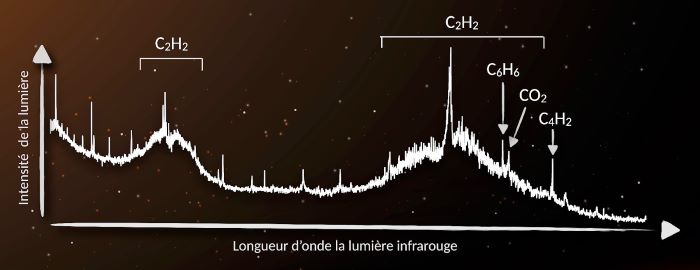James Webb Telescope reveals the composition of a protoplanetary disk
An international research team involving scientists from CNRS, the University of Paris-Saclay and CEA, supported by CNES, has just revealed the chemical composition of a Paris-Saclay University and the CEA, supported by the CNES, has just revealed the chemical composition of a disc of matter rotating around a young star, where new planets are forming.
Surprisingly, the disc is rich in hydrocarbons, with two molecules from this family even have even been detected for the first time in a disc. These results, published on 11 May 2023 in the journal Nature Astronomy were obtained thanks to the MIRI instrument developed by a consortium of laboratories in Europe and the United States.
|
This is where planets are born, in the heart of the disks of dust and gas that form around a young star after its birth. of a young star after its birth. Here, matter clumps together to form ‘protoplanets’, which continue to grow by gathering material from the The material clumps together to form ‘protoplanets’, which continue to grow by collecting material they encounter in the disc. However, our knowledge of this process is still limited. knowledge of this process is still limited.
Among the mysteries that still surround protoplanetary disks, scientists from 11 European countries 11 European countries in the MINDS (MIRI mid- Infrared Disk Survey) consortium have now partially the veil on their chemical composition. Observations of the very young star J1605323 and its disk with the James Webb Space Telescope have revealed surprisingly abundant hydrocarbons. surprisingly abundant. Some of these are even detected for the first time in a disc.

The MIRI spectrum of the star J160532. The emission lines of benzene (C6H6), diacetylene (C4H2) and carbon dioxide (CO2) appear as narrow peaks in the spectrum. Acetylene is so abundant that it produces two broad bumps in the spectrum. This indicates the dominance of hydrocarbons in the disc. Water emission, commonly observed in other disks, is weak or absent. Benoît Tabone/MINDS consortium/NASA/ESA
The consortium chose to focus on J160532 because of its low mass, in the order of five to ten times less than that of the Sun. Indeed, observations in recent years have shown that rocky exoplanets are very abundant around these ‘light’ stars. Moreover, these exoplanets often form in the habitable zone of their star, as shown by the famous Trappist-1 exoplanet system.
These results are a first glimpse of the potential of the James Webb Space Telescope to learn about the physical and chemical conditions that prevail during planet formation. Scientists now want to study the full diversity of protoplanetary disks to understand how the same physical processes that operate in all disks lead to the different types of planets observed in the Universe, including those in our Solar System.
Pour en savoir plus
Sous la maîtrise d’œuvre du CEA et la maîtrise d’ouvrage du CNES, plusieurs laboratoires français ont joué un rôle clef pour fournir l’imageur de MIRI : le laboratoire Astrophysique, instrumentation, modélisation (CEA/CNRS/Université Paris Cité), l’Institut d’astrophysique spatiale (CNRS/Université Paris-Saclay), le Laboratoire d’études spatiales et d’instrumentation en astrophysique (Observatoire de Paris-PSL/CNRS/Sorbonne Université/Université Paris Cité), le Laboratoire d’astrophysique de Marseille (CNRS/Aix Marseille Université).
En France, ces recherches ont impliqué des scientifiques de l’Institut d’astrophysique spatiale (CNRS/Université Paris-Saclay), du laboratoire Astrophysique, instrumentation, modélisation (CNRS/CEA/Université Paris Cité), du Laboratoire d’études du rayonnement et de la matière en astrophysique et atmosphères (Observatoire de Paris–PSL/CNRS/Sorbonne Université/Université de Cergy-Pontoise) et du Laboratoire de météorologie dynamique (CNRS/ENS-PSL/École polytechnique/Sorbonne Université), ainsi qu’un soutien financier du CNES. 3- J160532 s’est formée il y a environ trois millions d’années, contre plus de quatre milliards pour le Soleil à titre de comparaison.
Bibliography
A rich hydrocarbon chemistry and high C to O ratio in the inner disk around a very low-mass star.
Tabone et al. Nature Astronomy, le 11 mai 2023. DOI:10.1038/s41550-023-01965-3
https://www.nature.com/articles/s41550-023-01965-3
Contact
Agnès Perrin, LMD-IPSL •
Source : CNRS.






